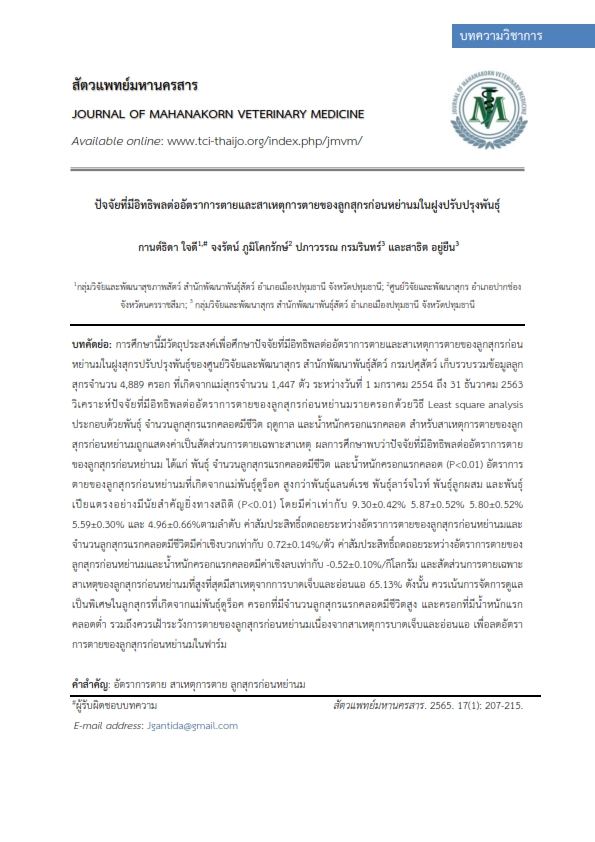Factors Affecting the Pre-Weaning Mortality Rate of Piglet and Cause of Pre-Weaning Mortality in a Breeding Farm
Main Article Content
Abstract
The objective of this study is to determine Pre-Weaning Mortality rate (PWM) of piglets of Swine Research and Development Center. The data were collected from 4,889 litters of 1,447 sows which giving birth during the period of 1st January 2011 to 31st December 2020. Factors including sow breeds, piglets’ born alive per litter, piglets’ birth weight per litter and season were analyzed by using Least Square analysis. The result showed that the factors significantly influencing PWM were sow breeds, piglets’ born alive per litter and piglets’ birth weight per litter (P<0.01). The PWM (9.30±0.42%) of Duroc breed was higher than those of Landrace (5.87±0.52%), Large white (5.80±0.52%), Crossbred (5.59±0.30%) and Pietrain (4.96± 0.66%) (P<0.01). Positive regression coefficient between PWM and piglets’ born alive per litter was found as 0.72±0.14 %/piglet, whereas the regression coefficient between PWM and piglets birth weight per litter was negative (-0.52±0.10%/kg). The cause-specific Proportional Mortality Ratios (PMR) in trauma combined with weakness was 65.13%. Therefore, postpartum care of sows and piglets should be concern over Duroc breed, high number of piglets born alive per litter and low birth weight. As well as, having appropriate in control of trauma and weakness to reduce PWM.
Article Details

This work is licensed under a Creative Commons Attribution-NonCommercial-NoDerivatives 4.0 International License.
References
Nuntapaitoon, M. and P. Tummaruk. 2013. Piglets pre-weaning mortality rate in a commercial swine herd in Thailand in relation to season, number of litter mates, sow's parity number and piglet's birth weight. Proceedings of 51st Kasetsart University Annual Conference: Veterinary Medicine, Fisheries. Bangkok, Thailand, TFR, 5-7 February 2013: 58-64. (in Thai)
Bunger, L., R.M. Lewis, M.F. Rothschild, A. Blasco, U. Renne, and G. Simm. 2005. Relationships between quantitative and reproductive fitness traits in animals. Philos. Trans. R. Soc. Lond. B. Biol. Sci. 360: 1489-1502.
Edwards, S.A. 2002. Perinatal mortality in the pig: environmental or physiological solutions? Livest. Prod. Sci. 78(1): 3–12.
Jaichansukkit, T., T. Suwannasopee, S. Koonawootrittriron, and M.A. Elzo. 2016. Association between number of piglets lost and total number of piglets born from commercial sows raised under an open-house system. Kaen Kaset. 44(2): 350-356. (in Thai)
Kilbride, A.L., M. Mendl, P. Statham, S. Held, M. Harris, S. Cooper, and L.E. Green. 2012. A cohort study of weaning piglet mortality and farrowing accommodation on 122 commercial pig farms in England. Prev. Vet. Med. 104(3-4): 281-291.
Kirkden, R.D., D.M. Broom, and I.L. Andersen. 2013. Piglet mortality: The impact of induction of farrowing using prostaglandins and oxytocin. Anim. Reprod. Sci. 138(1-2): 14-24.
Koketsu, Y., R. Iida, and C. Pineiro. 2021. A 10-year trend in piglet pre-weaning mortality in breeding herds associated with sow herd size and number of piglets born alive. Porcine Health Manag. 7(4): 1-4.
Koketsu, Y., S. Takenobu, and R. Nakamura. 2006. Preweaning mortality risks and recorded causes of death associated with production factors in swine breeding herds in Japan. J. Vet. Sci. 68(8): 821-826.
Li, Y., L.J. Johnston, and A.M. Hilbrands. 2010. Pre-weaning mortality of piglets in a bedded group-farrowing system. J. Swine Health Prod 18(2): 75-80.
Muns, R., E.G. Manzanilla, C. Sol, X. Manteca, and J. Gasa. 2013. Piglet behavior as a measure of vitality and its influence on piglet survival and growth during lactation. J. Anim. Sci. 91(4): 1838–1843.
Muns, R., M. Nuntapaitoon, and P. Tummaruk. 2016. Non-infectious causes of preweaning mortality in piglets. Livest. Sci. 184: 46–57.
Muns, R. and P. Tummaruk. 2016. Management strategies in farrowing house to improve piglet pre-weaning survival and growth. Wetchasan Sattawaphaet 46(3): 347–354.
Nuntapaitoon, M., R. Muns, and P. Tummaruk. 2018. Newborn traits associated with pre-weaning growth and survival in piglets. Asian-Australas. J. Anim. Sci. 31(2): 237–244.
Nuntapaitoon, M. and P. Tummaruk. 2018. Factors influencing piglet pre-weaning mortality in 47 commercial swine herds in Thailand. Trop Anim. Health Prod. 50(1): 129–135.
Nuntapaitoon, M. and P. Tummaruk. 2013. Piglets pre-weaning mortality rate in a commercial swine herd in Thailand in relation to season, number of litter mates, sow's parity number and piglet's birth weight. Proceedings of 51st Kasetsart University Annual Conference: Veterinary Medicine, Fisheries. Bangkok, Thailand, TFR, 5-7 February 2013: 58-64. (in Thai)
Pedersen, L.J., S.L.A. Schild, and J. Malmkvist. 2015. The influence of the thermal environment and other early life events on growth rate of piglets during lactation. Animal. 9(9): 1529–1535.
Quesnel, H., L. Brossard, A. Valancogne, and N. Quiniou. 2008. Influence of some sow characteristics on within-litter variation of piglet birth weight. Animal. 2(12): 1842–1849.
Shankar, B.P., H.S. Madhusudhan, and D.B. Harish. 2009. Pre-weaning Mortality in Pig-cause and Management. Vet. World. 2(6): 236-239.
Tuchscherer, M., B. Puppe, A. Tuchscherer, and U. Tiemann. 2000. Early identification of neonates at risk: Traits of newborn piglets with respect to survival. Theriogenology. 54(3): 371-388.


